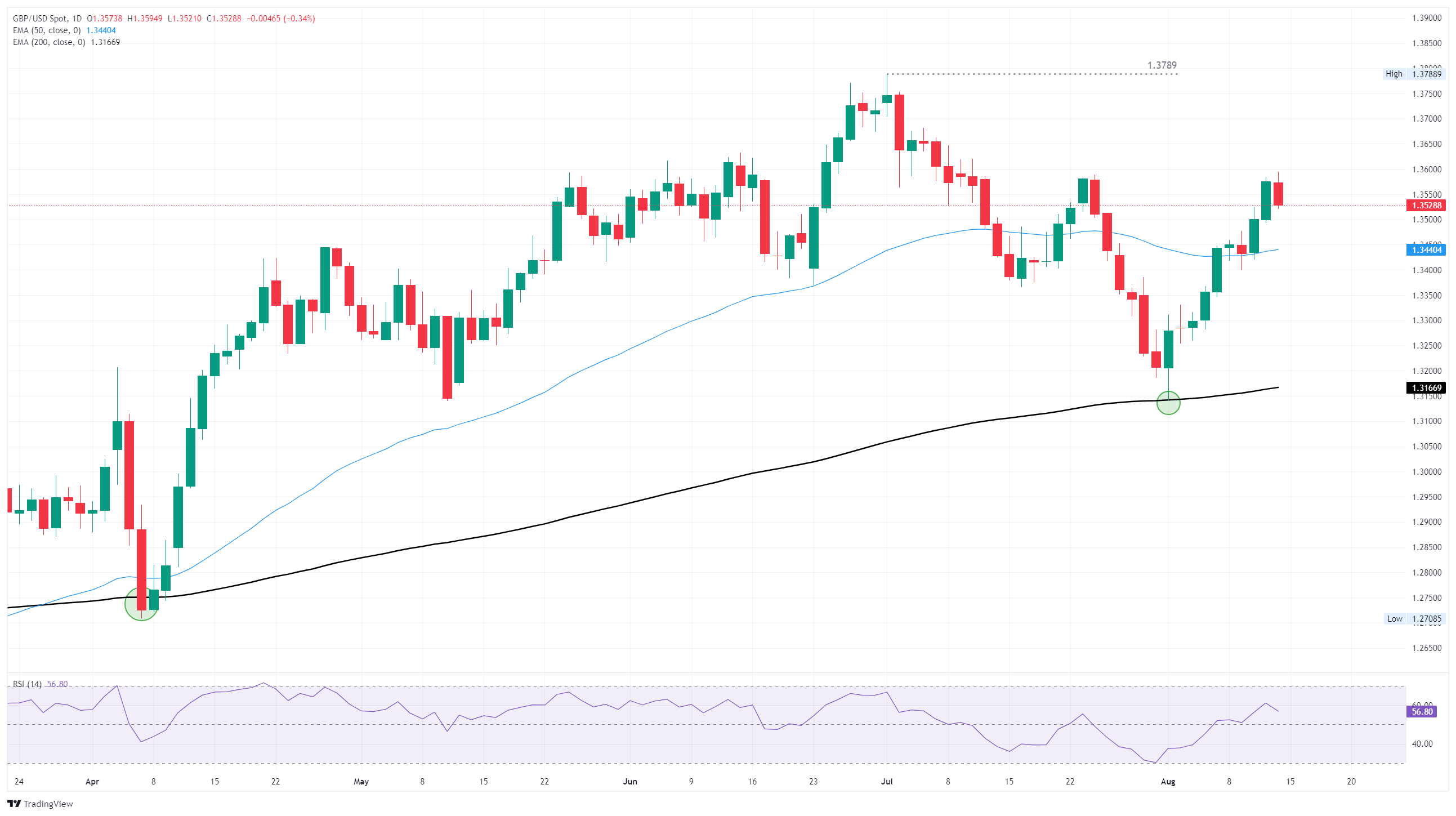- GBP/USD declined on Thursday, driven back by rising Greenback demand.
- US PPI inflation surged higher in July, sparking a flight into US Dollar safety.
- Markets trimmed their bets for multiple Fed rate cuts through the end of the year.
GBP/USD recoiled from rising US inflation metrics on Thursday, sending the US Dollar (USD) broadly higher and snapping a two-day winning streak in the Cable-Dollar pairing. GBP/USD saw its largest single-day decline in over two weeks, pushing the pair back toward 1.3500 after flubbing a technical push toward 1.3600.
Despite getting trimmed lower by around one-third of one percent, GBP/USD is still holding firmly onto the bullish side. Cable is still trading well above the 200-day Exponential Moving Average (EMA) near 1.3170, and immediate technical support is priced in at the 50-day EMA near 1.3440. Momentum has been a one-sided affair in favor of bidders, although the lower-highs patten baked into daily candlesticks is under threat of breaking down.
US inflation heats up, crimps Fed rate cut hopes
UK GDP figures broadly came in above expectations early Thursday, with the UK economy growing 0.3% QoQ versus the expected slowdown to 0.1%. Industrial Production also rebounded more than expected, recovering 0.7% MoM in June, however, May’s figure was revised lower to -1.3%.
On the US side, Producer Price Index (PPI) inflation rocketed back to multi-month highs of 3.3%, while core PPI inflation soared to 3.7% YoY. Rising inflation pressures knocked back expectations for three rate cuts from the Federal Reserve (Fed) by the year’s end, but rate markets are still pricing in at least two rate cuts with over 90% confidence that the Fed will trim interest rates by 25 bps on September 17.
US Retail Sales and the University of Michigan’s (UoM) Consumer Sentiment Index will be the main data drivers on Friday. US President Donald Trump’s repeatedly announced meeting with Russian President Vladimir Putin will also take place on Friday, giving traders plenty of headline-watching time to round out the trading week. Despite his repeated claims and insistence on being a world-class negotiator and dealmaker, President Trump has faced repeated struggles in securing the concessions he wants from other countries during both of his presidential terms.
GBP/USD daily chart

Pound Sterling FAQs
The Pound Sterling (GBP) is the oldest currency in the world (886 AD) and the official currency of the United Kingdom. It is the fourth most traded unit for foreign exchange (FX) in the world, accounting for 12% of all transactions, averaging $630 billion a day, according to 2022 data.
Its key trading pairs are GBP/USD, also known as ‘Cable’, which accounts for 11% of FX, GBP/JPY, or the ‘Dragon’ as it is known by traders (3%), and EUR/GBP (2%). The Pound Sterling is issued by the Bank of England (BoE).
The single most important factor influencing the value of the Pound Sterling is monetary policy decided by the Bank of England. The BoE bases its decisions on whether it has achieved its primary goal of “price stability” – a steady inflation rate of around 2%. Its primary tool for achieving this is the adjustment of interest rates.
When inflation is too high, the BoE will try to rein it in by raising interest rates, making it more expensive for people and businesses to access credit. This is generally positive for GBP, as higher interest rates make the UK a more attractive place for global investors to park their money.
When inflation falls too low it is a sign economic growth is slowing. In this scenario, the BoE will consider lowering interest rates to cheapen credit so businesses will borrow more to invest in growth-generating projects.
Data releases gauge the health of the economy and can impact the value of the Pound Sterling. Indicators such as GDP, Manufacturing and Services PMIs, and employment can all influence the direction of the GBP.
A strong economy is good for Sterling. Not only does it attract more foreign investment but it may encourage the BoE to put up interest rates, which will directly strengthen GBP. Otherwise, if economic data is weak, the Pound Sterling is likely to fall.
Another significant data release for the Pound Sterling is the Trade Balance. This indicator measures the difference between what a country earns from its exports and what it spends on imports over a given period.
If a country produces highly sought-after exports, its currency will benefit purely from the extra demand created from foreign buyers seeking to purchase these goods. Therefore, a positive net Trade Balance strengthens a currency and vice versa for a negative balance.

